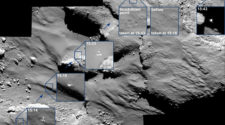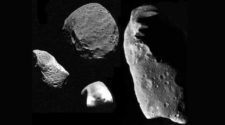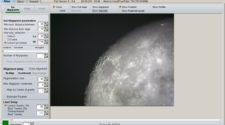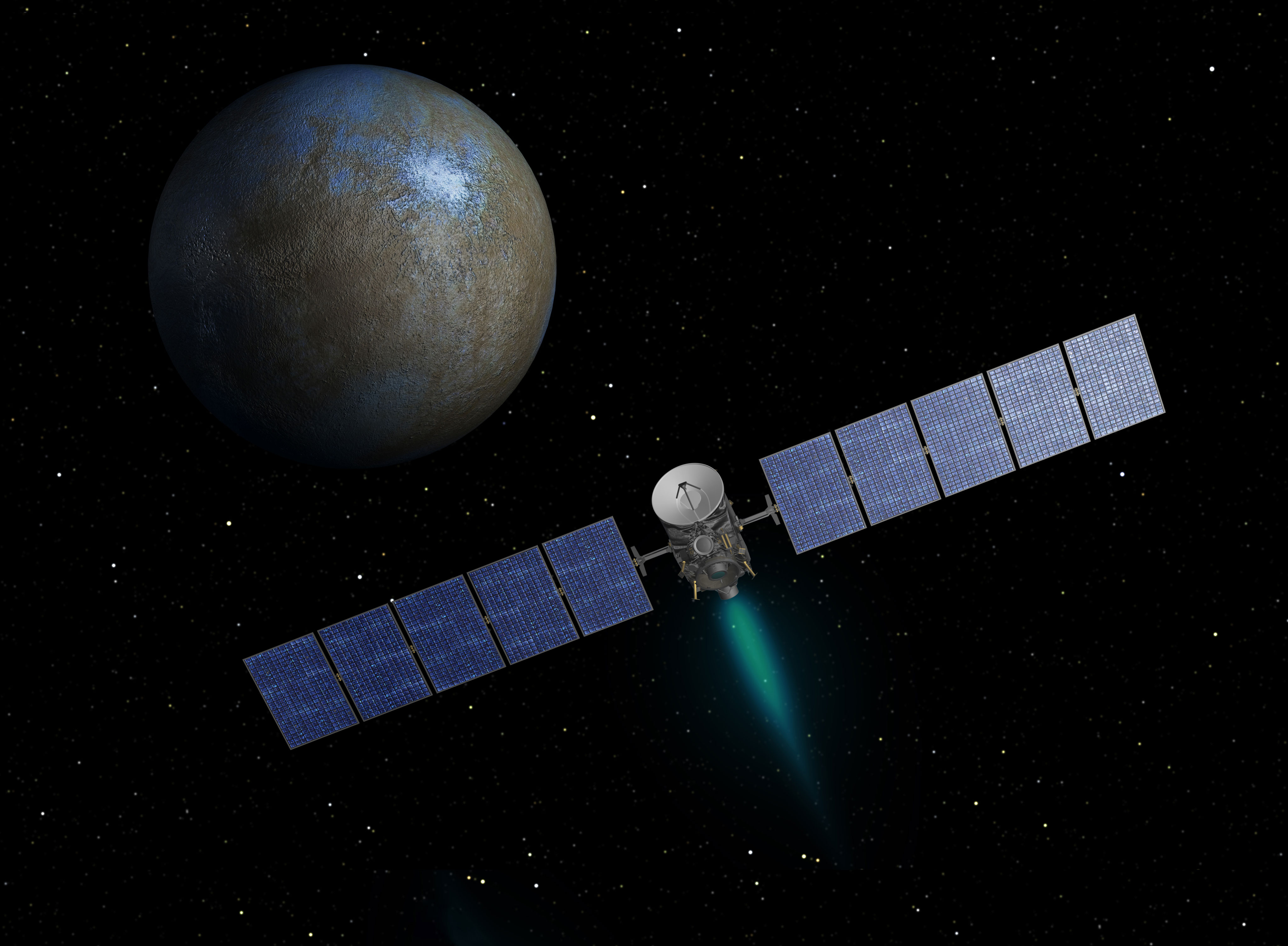
As we celebrate the tenth anniversary of Huygens’ descent to the surface of Saturn’s giant satellite Titan, humanity’s first landing on an outer solar system moon, and the continuing success of its parent craft Cassini, we look forward to an extraordinary year of robotic solar system exploration in 2015, and one which should bring new insights into the origins of the Earth and of our Solar System.
This is a thrilling period of discovery in which we are pushing back the frontiers of planetary science. Having visited the major planets and their systems of satellites and rings, we are now delving more deeply back through time than ever before, to the earliest days of the Sun’s rich and diverse family of worlds, big and small, and even to the period shortly after the condensation of the Solar Nebula when they were still assembling.
The European Space Agency’s (ESA’s) Rosetta spacecraft, having entered into orbit around Comet 67P/Churyumov-Gerasimenko in September last year, and having successfully put down the Philae lander on its surface, will accompany this former Kuiper Belt world to its perihelion on 13th August 2015 and beyond. (And all of this after encounters with two main-belt asteroids too!) As well as studying changes in the comet as it approaches the Sun, then during its departure, it is hoped that the Rosetta mission may provide more information about the birth of the solar system and even, perhaps, the origins of life on Earth.
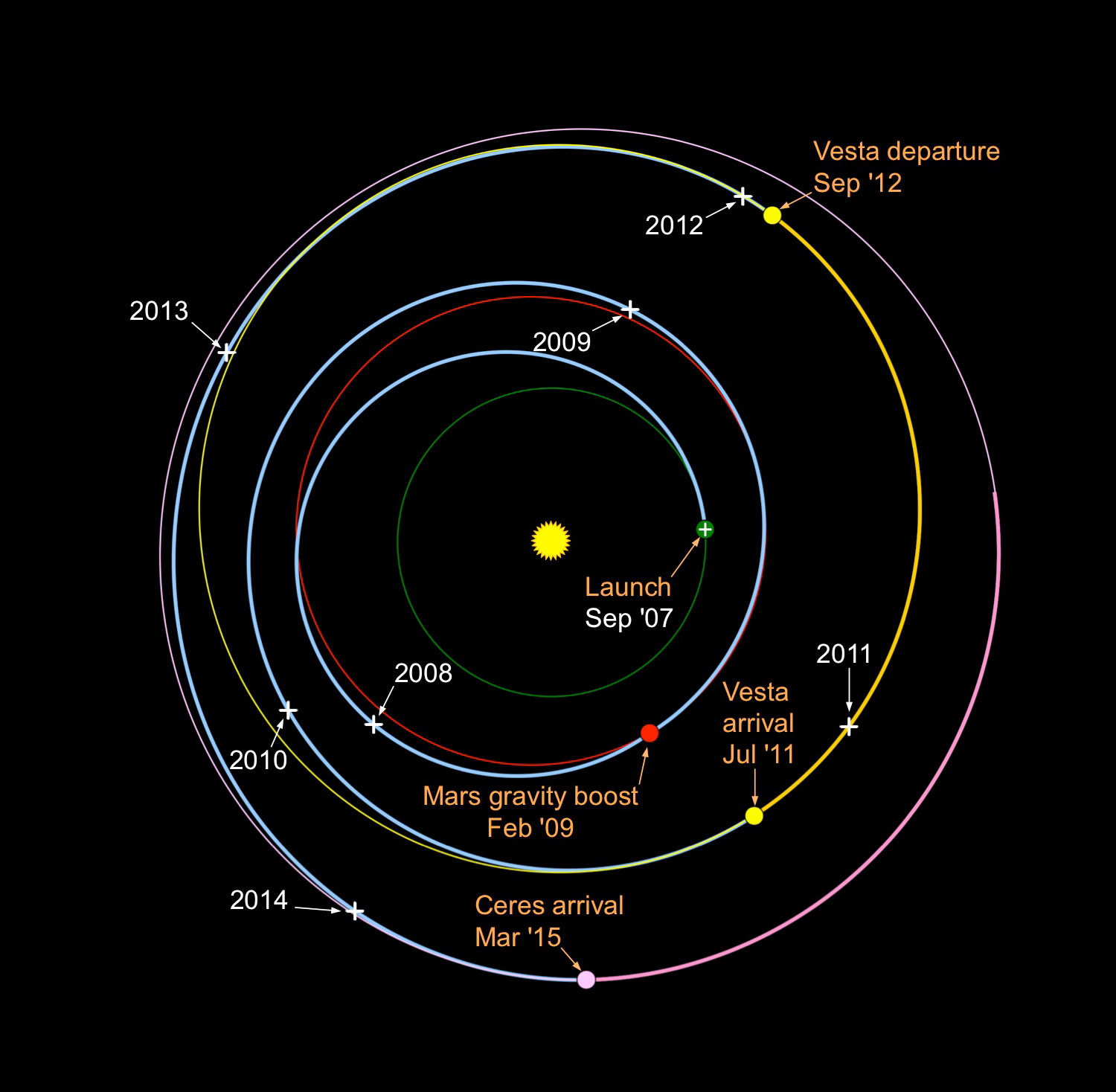
Another highlight of the coming summer will be the first ever fly-by of dwarf planet Pluto and its system of moons by the New Horizons spacecraft (NASA/Johns Hopkins University APL/South-West Research Institute) on July 14th, which should shed more light on the evolution of the frigid, outer regions of the solar system, just beyond the realm of the major planets. The revelation of Triton’s active surface during the Voyager 2 fly-by of the Neptune system in 1989 and recent Earth-based and HST observations of Pluto lead us to expect an exciting encounter.
Before that, however, on 6th March, the Dawn spacecraft will enter the final phase of its incredible odyssey through the main-asteroid belt when it enters orbit around dwarf planet Ceres, ‘easing into (its) gravitational embrace’, as Dr. Marc Rayman, the project’s Chief Engineer and Mission Director at JPL, poetically says in his engaging and regularly updated ‘Dawn Journal’ at http://dawn.jpl.nasa.gov/mission/journal.asp. The probe will become a permanent satellite of the dwarf planet, having already spent 14 months orbiting and studying asteroid 4 Vesta, which makes Dawn unique so far in orbiting two separate bodies beyond the Earth-Moon system. Its primary mission of observing Ceres in detail is planned to last until summer 2016.
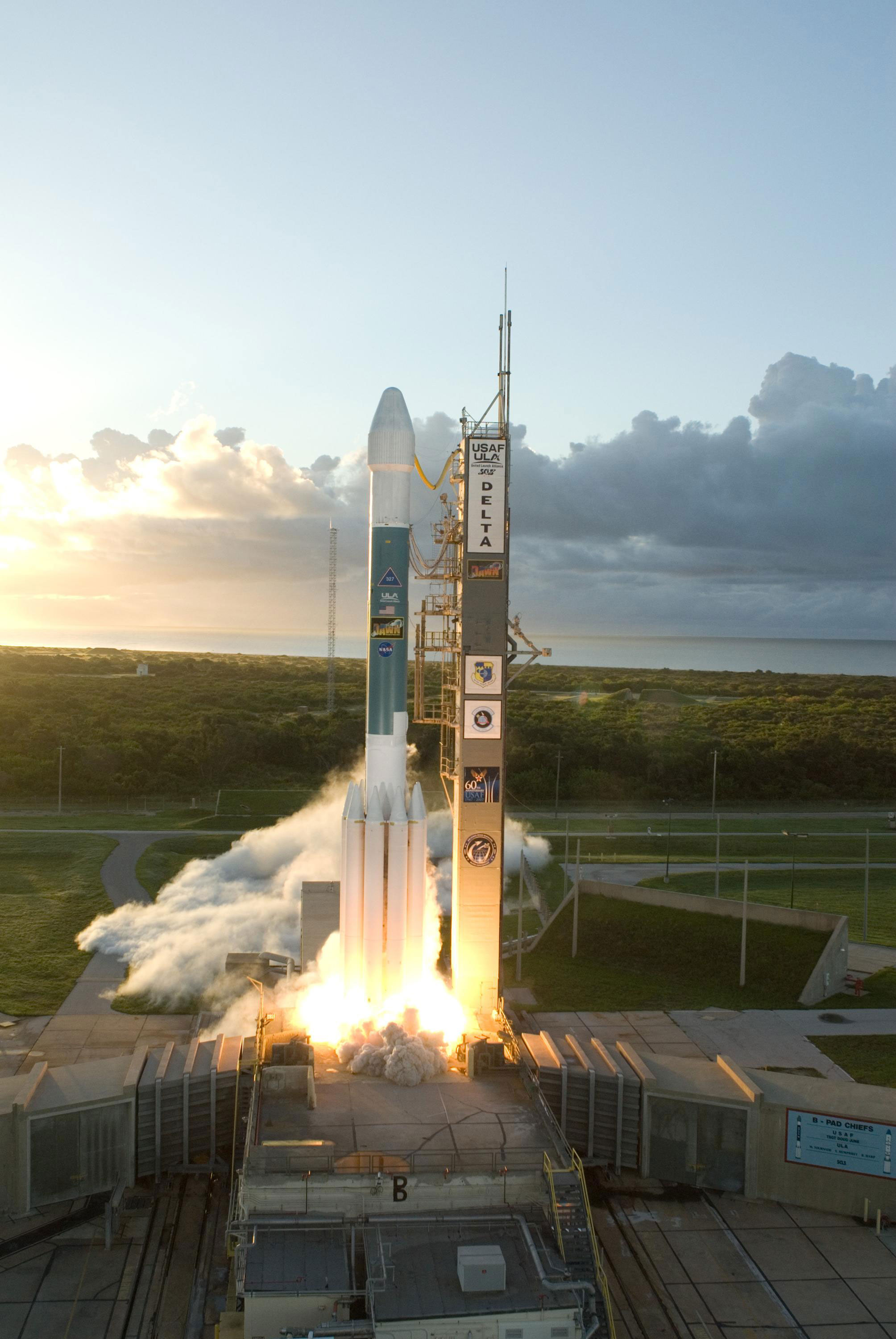
Mission origins and development
Dawn is targeted specifically at investigating the main asteroid belt between Mars and Jupiter. It is one of NASA’s Discovery Program missions, initiated in the 1990s to complement NASA’s bigger “flagship” planetary explorations with more frequent, smaller missions at lower cost and with shorter development times. All completed Discovery missions – from NEAR-Shoemaker to MESSENGER, Pathfinder to GRAIL, Kepler and others – have enjoyed great success. The Program has also aimed to develop and use new technologies, as well as broadening collaboration between NASA and university and industry partners, both in the USA and abroad.
The partnership for Dawn has brought together:
- Jet Propulsion Laboratory (JPL), who are responsible for overall mission planning and management, development of the science payload, flight systems, and also for the spacecraft’s ion propulsion system;
- Orbital Sciences Corporation, the spacecraft’s manufacturers;
- The science team, led by Principal Investigator Professor Christopher Russell of the University of California, Los Angeles (UCLA), who initially proposed the mission to NASA, and his colleagues at the Institute of Geophysics and Planetary Physics, together with scientists from other universities and institutions across the USA and in Europe.
Then there are also the many groups which have supplied Dawn’s science payload which consists of three main instruments:
- The Framing Cameras for use in imaging Vesta and Ceres, and also for optical navigation, developed and built by The Max Planck Institute for Solar System Research in Germany, together with the Institute for Planetary Research of the German Aerospace Center and the Institute for Computer and Communication Network Engineering of the Technical University of Braunschweig.
- Visible and Infrared (VIR) Mapping Spectrometer, used to determine the surface mineralogy of both Vesta and Ceres, provided by the Italian Space Agency, designed and built at Galileo Avionica, in partnership with Italy’s National Institute for Astrophysics.
- A Gamma Ray and Neutron Detector for detecting the elemental composition of both Vesta and Ceres, developed by Los Alamos National Laboratory, Los Alamos, New Mexico.
The spacecraft’s radio transmitter will also be used in conjunction with sensitive antennas on Earth to study the gravity fields of the two bodies and to provide clues as to their internal structure.
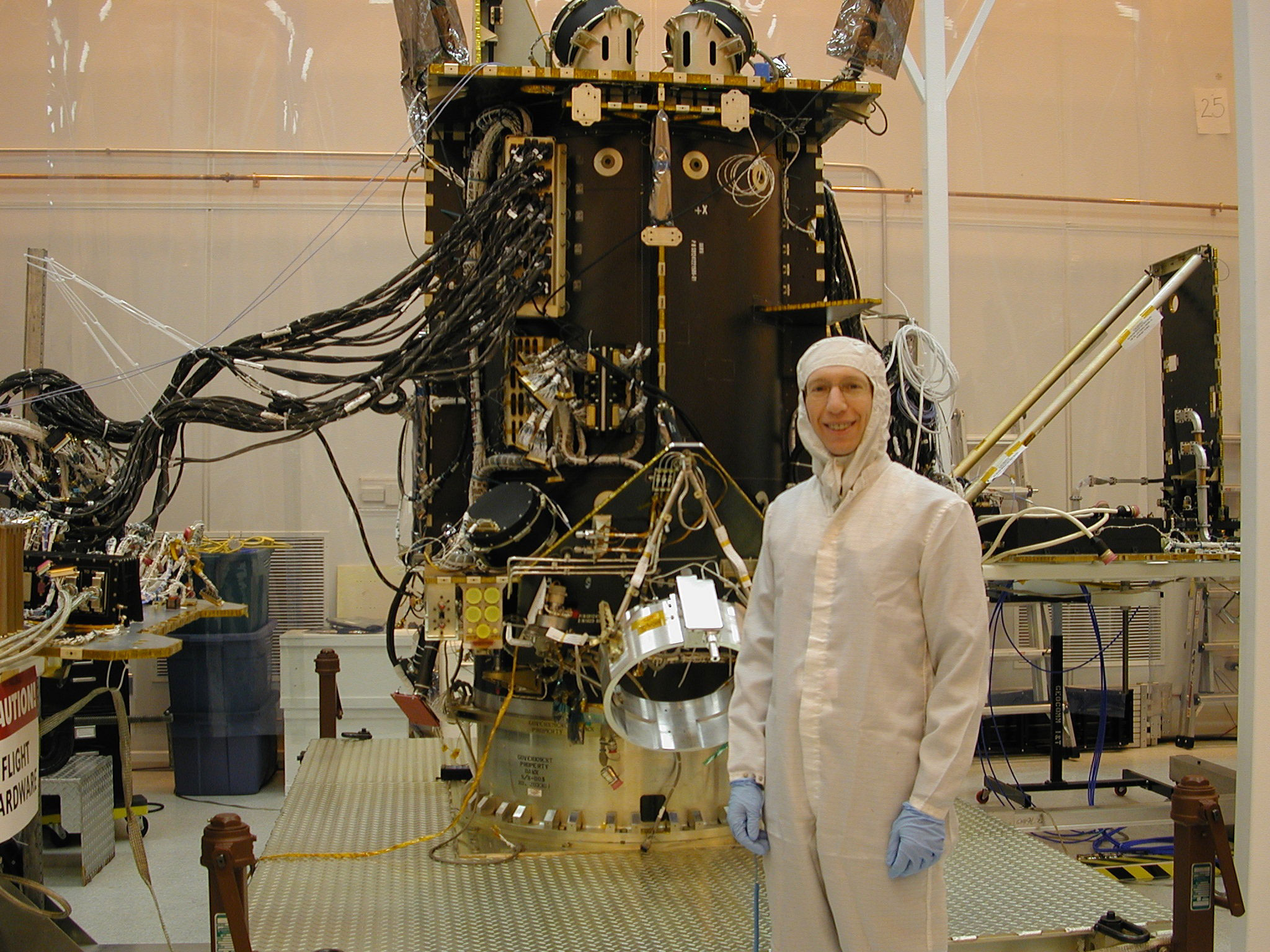
‘A fantastic return!’
At a time when spending on planetary exploration is being squeezed, and we often hear questions about ‘why money should be spent on space’, Dawn (like Rosetta at 20 centimes per European citizen per year!) is a great advertisement for the cost-effectiveness and enormous returns of such scientific projects. The total cost of Dawn at launch on September 2007 came in at US$ 446 million. Marc Rayman says,‘at about $US 1.50 per inhabitant of the USA – just 75¢ per world, the price of a can of coke – that’s a pretty good deal. I think the return truly is fantastic!’ This can only help to dispel the habitual myths which surround the funding of space exploration in the public imagination. And of course there are far greater benefits, as Dr. Rayman explains: ‘We are lucky to live in a culture in which we have the resources to invest in such projects, just as we do in art. These enrich all of us, help us discover our place in the Universe and open our eyes to new worlds, both literally and figuratively.’
Ion Propulsion
An important part of the return from the mission is the proving of alternative technologies. The radical choice of propulsion system has been of particular importance in enabling Dawn to achieve its ambitious goals. Visiting and orbiting two different bodies has been made possible thanks to an advanced ion thrust propulsion system, developed by NASA. Dawn’s engines are based on the system used successfully on the Deep Space 1 trial mission for new technologies between October 1998 and December 2001. A simplified view of how the system works is shown in the attached graphic. For a detailed description of the ion propulsion technology used for the mission, visit http://www.nasa.gov/centers/glenn/about/fs21grc.html.
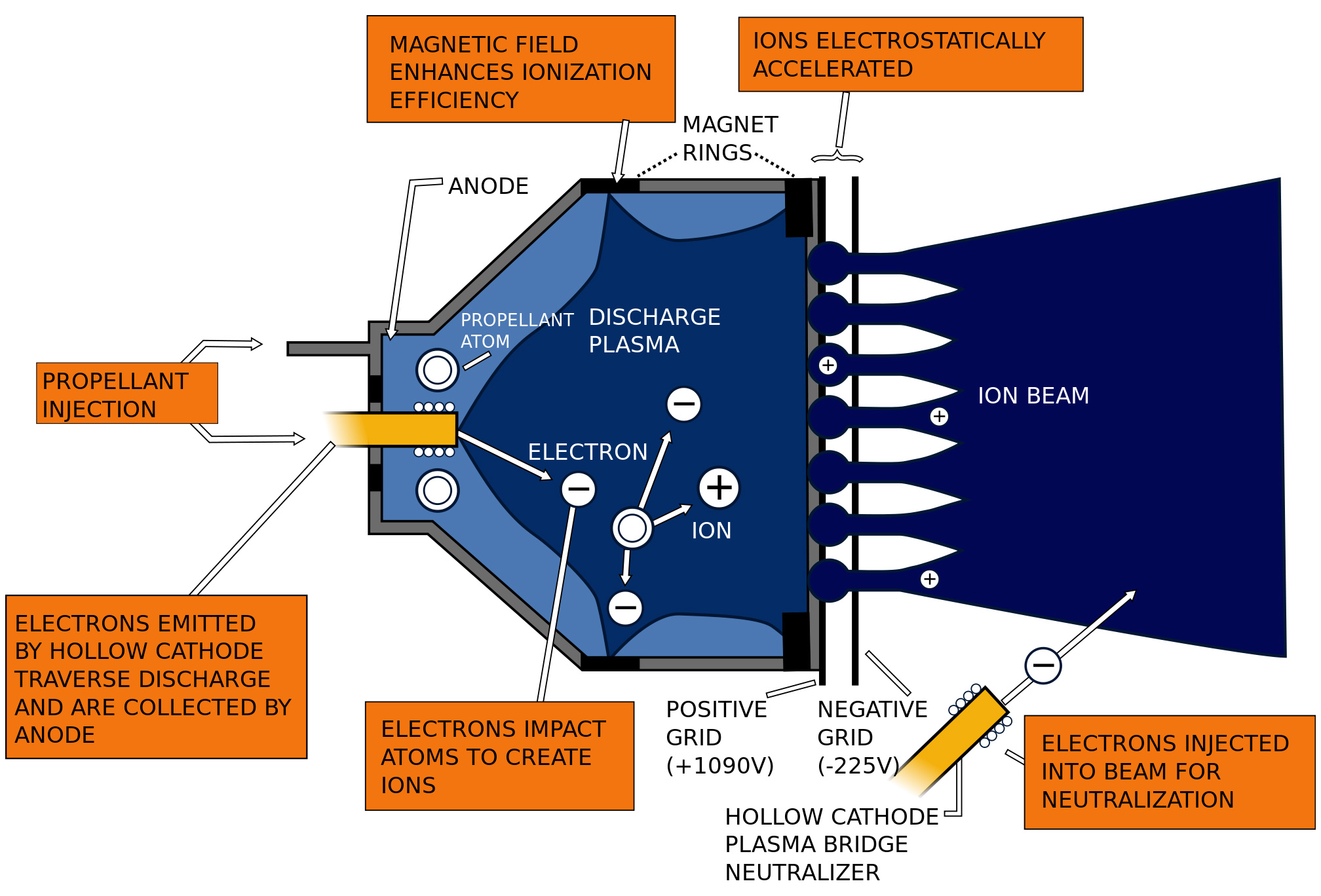
Following its launch on a Delta II from Cape Canaveral on 27th September 2007, Dawn has used three xenon ion thrusters (firing only one at a time) to take it in a long outward spiral from Earth into the main asteroid belt, via a gravity assist from Mars. The spacecraft’s trajectory and timeline are shown in Figure 6. The engines have a specific impulse of 3100s and a thrust of 90 millinewtons (mN), and are capable of acceleration from 0 to 60 mph (97 km/h) in 4 days, firing continuously. While a chemical rocket on a spacecraft might have a thrust of up to 500 newtons (N = kg m s-2), Dawn’s much smaller engine can achieve the same change in trajectory by firing over a much longer period of time, and, above all, using far less fuel.
This is particularly significant when planning rendezvous and orbital insertion manoeuvres, which is why Dawn is able to catch up with and orbit two separate bodies.
By October of 2014, as Marc Rayman explains in his online journal, the spacecraft had thrusted for 1,737 days (68% of its journey), using only 366kg (808 pounds) of xenon propellant out of its total reserve of 425 kg (937 pounds). ‘By the end of its mission, having operated from its maximum throttle level down to lower levels when Dawn was much farther from the Sun, the spacecraft will have accumulated over 5 years of total thrust time, giving it an effective change in speed of 11 kilometers/second, or well over 24,000 miles/hour. That is about the same as the entire Delta rocket with its nine solid motor strap-ons, first stage, second stage, and third stage, and it is far in excess of what any single-stage craft has accomplished.’
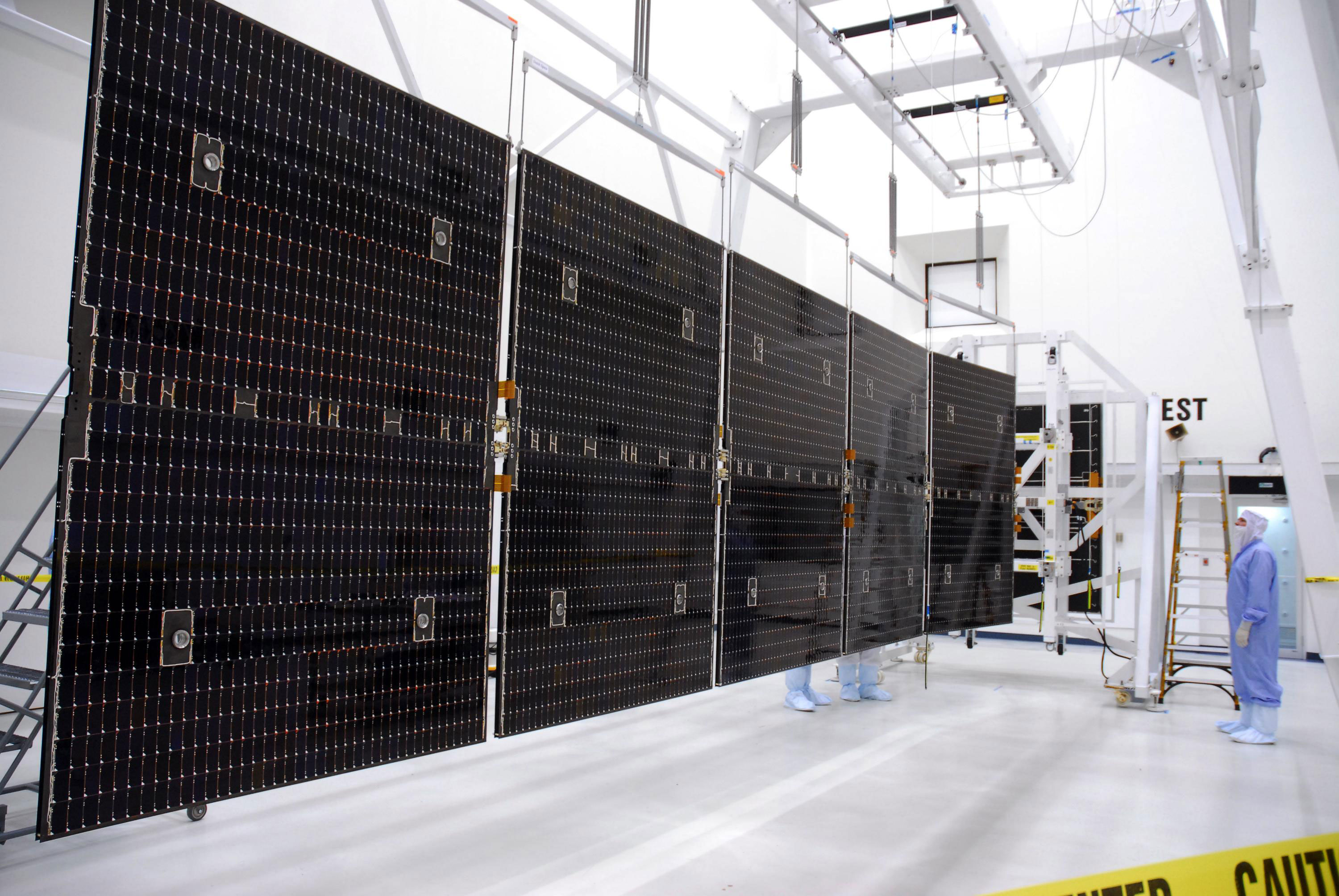
The target worlds: Why Ceres and Vesta?
Launched by NASA on September 27, 2007, Dawn’s targets for study are two of the most massive objects of the asteroid belt. While small compared to Earth, dwarf planet Ceres (formerly asteroid 1 Ceres) contains roughly 30% of the total mass in that region of space and protoplanet Vesta (fromerly asteroid 4 Vesta) 8%, so Dawn is exploring almost 40% of the asteroid belt’s mass. For other statistics on these worlds, see Table 1 below.

Both bodies are regarded as protoplanets, representative of the final, bigger planetary embryos, which came together to form the planets almost 4.6 billion years ago. Only a few of these now remain in the inner solar system. Dawn is revealing the conditions under which these objects formed and the different ways in which they have evolved in this key region close to where the so-called ‘frost-line’ may have existed. This is the limit beyond which water was able to condense into ice, due to lower temperatures in the solar nebula, whereas in the hotter environments closer to the early Sun water would have combined with other substances to form hydrated minerals.
Ceres and Vesta have been altered much less than other bodies. The Earth is very active and constantly evolving, but Ceres and Vesta are ancient and have preserved a record of the early solar system. Dawn’s mission’s goals include determining their composition and internal structure. By examining their surfaces and how they have been modified by impactors over time, we can get an idea of what the early conditions of Ceres and Vesta were like and how they have evolved since then. Vesta appears to have been hot and dry, like the terrestrial planets, and experienced at least partial melting, whereas water seems to have played a role in keeping Ceres much cooler, so that it may be less evolved.
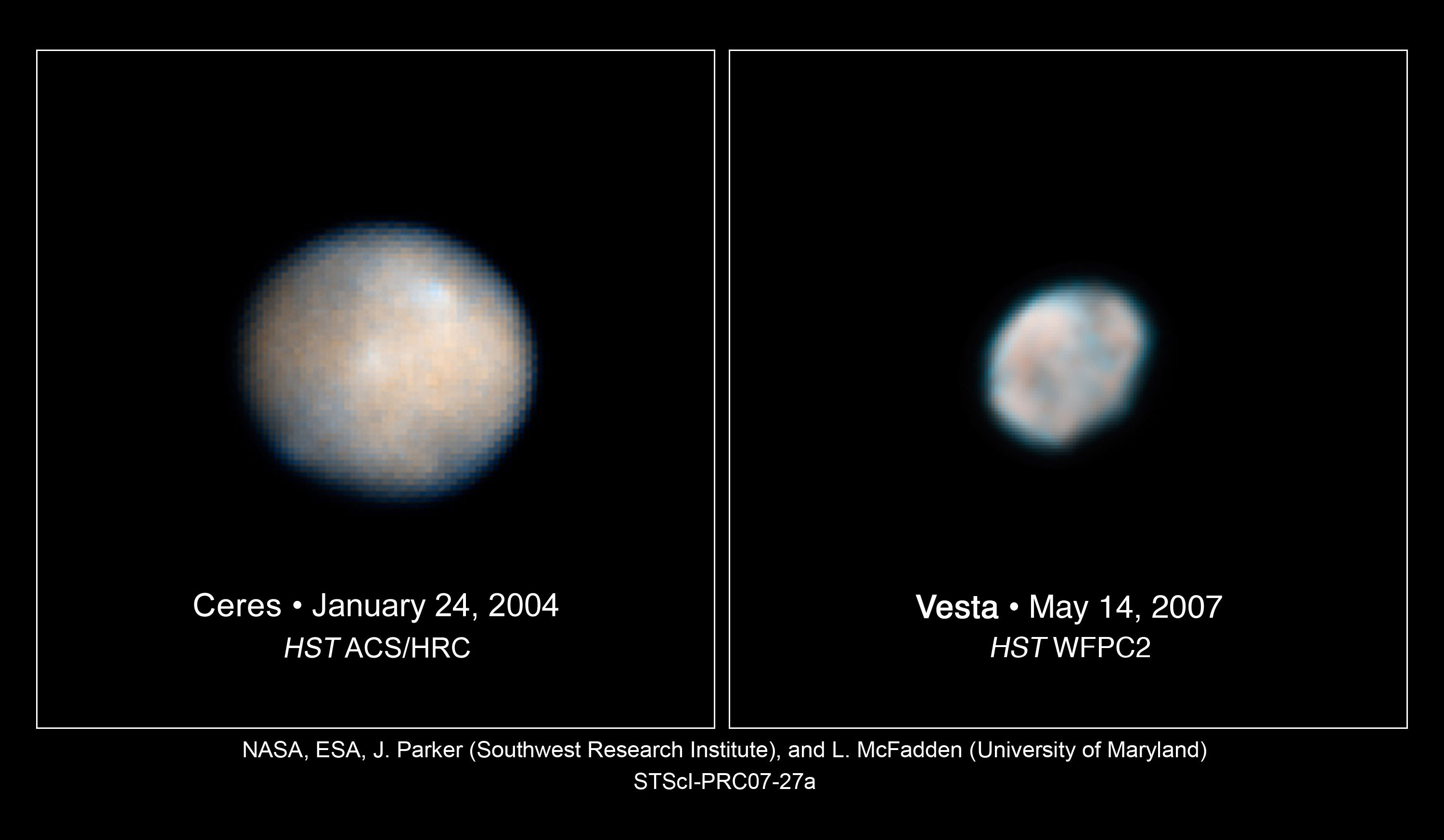
The images were used to help astronomers plan for the Dawn spacecraft’s tour of these hefty asteroids before it even launched.
A battered world: Vesta revealed
Vesta, discovered by Heinrich Wilhelm Olbers on 29 March 1807, is named after the virgin goddess of home and hearth in Roman mythology. Dawn was the first spacecraft to visit Vesta, entering orbit on July 16, 2011, and successfully completing its fourteen month survey mission of this fascinating body in late 2012.
Dawn’s instruments have revealed a rocky, battered world which reflects the violent early history of the solar system. It accreted from the planetesimals in the region and would perhaps have joined with similar large planetary embryos to form a planet-sized body, were it not for the gravitational influence of massive Jupiter, which disrupted and prevented planet formation in the main asteroid belt, an explanation for the plethora of bodies in this region today.
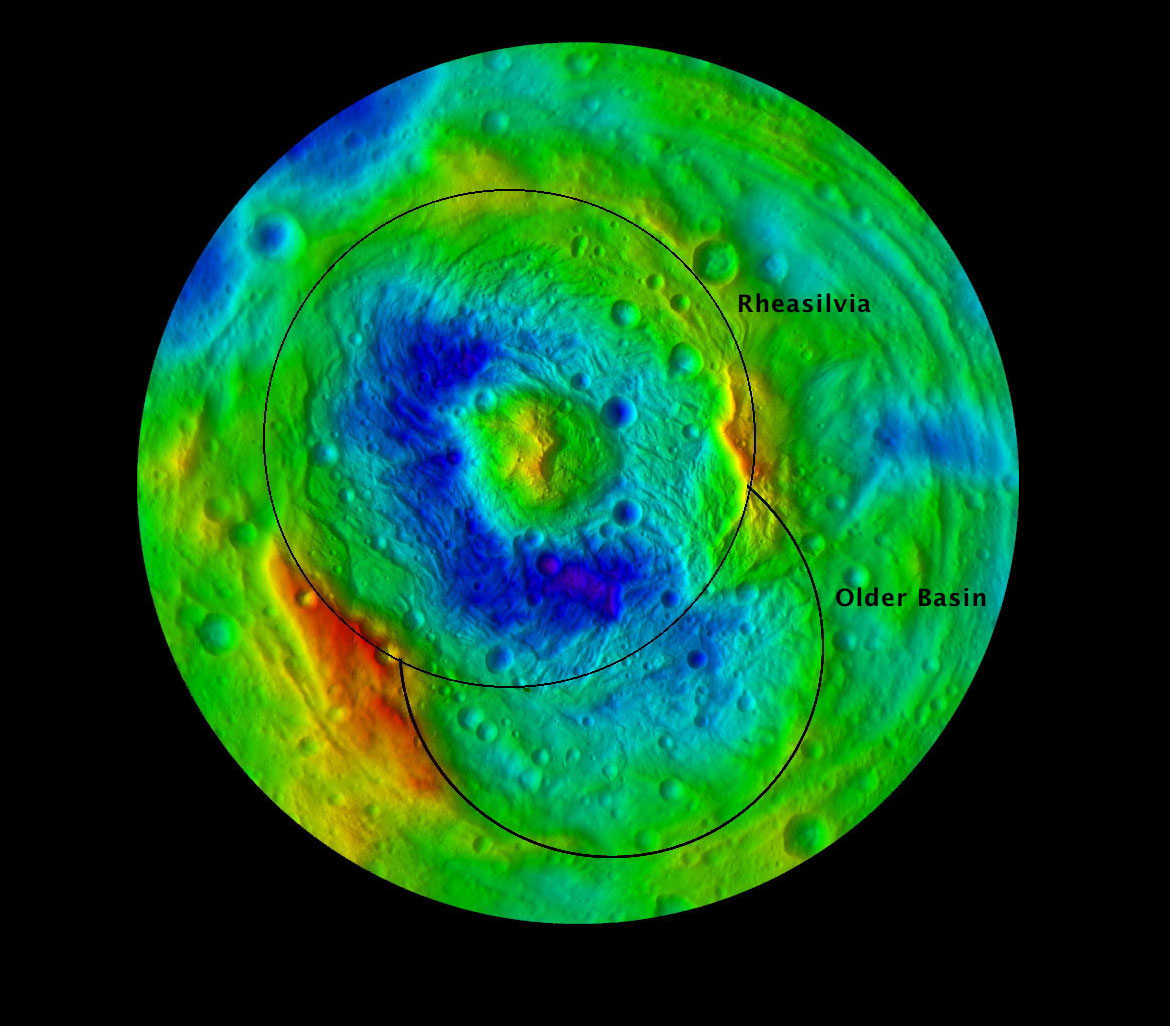
Representative of the type of bodies which eventually collided to form the Earth and other inner planets, it is probably the last of its kind. Dawn has shown us good evidence for the internal differentiation of Vesta, with a thin crust and rocky (silicate) mantle overlying a metal-rich (iron-nickel) core, estimated to be about 220km (136 miles) across. This layering, which is uncommon among asteroids, is borne out by its mean density which is similar to that of our Moon, and not much less than that of Mars (3.93 g/cm3). Differentiation would have occurred as heating from radioactive decay, large impacts, and gravitational pressure melted parts of the protoplanet as it grew. In melted zones heavier elements sank to the center, while lighter materials rose to the surface. The core is now solid, unlike that of the larger Earth which remains hot, thanks largely to radiogenic heating, the heat released by the radioactive decay of certain elements.
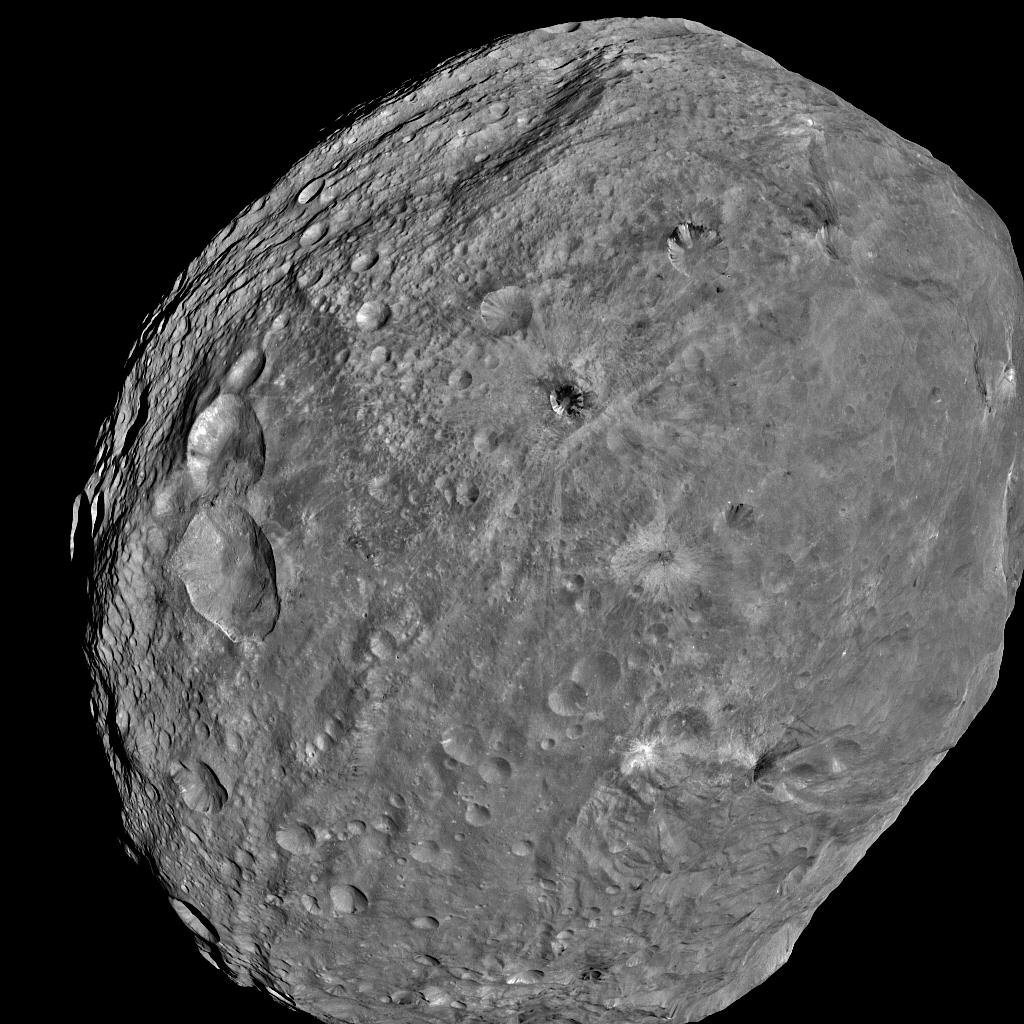
A major source of heating at Vesta will have been impacts, much more frequent during the accretion process when there was a lot more material to be swept up in the inner solar system. There is much evidence of these impacts, both on its heavily cratered and fractured surface, and also in fragments originating from them, many of which end up falling to Earth and other terrestrial bodies as meteorites. An estimated 6% of all meteorites observed on our own planet come from Vesta. Analysis of materials found in them provides supporting evidence for differentiation in the growing protoplanet.
On Vesta itself the scale and violence of impacts early in its history is borne out by at least seven craters of over 150km in diameter. Most impressive is the scar of an impact which may have come close to smashing Vesta apart, the giant crater named Rheasilvia. The impactor was probably as much as 50km (30 miles) across, and the resulting basin in Vesta’s south polar region is 500km (300 miles) across, 12km (7.5 miles) deep and is distinguished by a central peak which rises to almost 25km (15 miles) above the basin floor. The image on the preceeding page gives an idea of the scale of this feature. The event sent monumental seismic shock waves through Vesta which caused many faults and troughs around its equatorial regions, as well as blanketing the southern half of the protoplanet with a thick layer of debris. This explains the less cratered nature of the south in contrast to the northern regions.
Beyond the rim of Rheasilvia, the rest of Vesta’s tormented surface is no less spectacular, and the stories it tells of the distant past will gradually be deciphered by Dawn’s science team. The spacecraft broke free from Vesta’s sphere of influence in September 2012 to head out towards its next destination, but its mission there is far from over. Its sensors have returned sufficient data on this unique world to keep mission scientists busy for decades, together with the continuing study of meteorites here on Earth.
Onward to Ceres
Having begun to unlock the secrets of one new world, we look forward to discovering another unique member of our Sun’s family of worlds. Ceres, named for the Roman goddess of corn and harvests, grows ever more clear in Dawn’s cameras, becoming a whole new world for us. This will be, to quote Dr. Rayman, ‘an ambitious and exciting exploration of the alien world ahead… an intriguing and mysterious orb that has beckoned for more than two centuries.…. Our goal is to develop that faint smudge of light amidst the stars into a richly detailed portrait.’
Since its discovery on 1st January 1801 by Giuseppe Piazzi, Ceres has been considered firstly as a planet, then an asteroid (or minor planet) and, since 2006, as a dwarf planet. However we classify it today, with a mean diameter of 952km (591 miles) it is the largest body between the Sun and Pluto yet to be visited by a space probe, and appears to be very different from Vesta and most other bodies in the main asteroid belt. It has a density closer to that of the big icy moons of the giant planets, like Ganymede (1.93 g/cm3) or Titan (1.88 g/cm3). Ceres is expected to present, beneath a thin dusty crust, a differentiated structure, but one with a water ice mantle some 100km (60 miles) thick surrounding a rocky, silicate core. The presence of ice is expected to have created differences in the dwarf planet’s surface features, when compared to those of Vesta, due to the more flexible nature of ice than that of the latter’s rocky surface, even at the relatively low temperatures (130K-200K or -73°C to -143°C) found at Ceres.
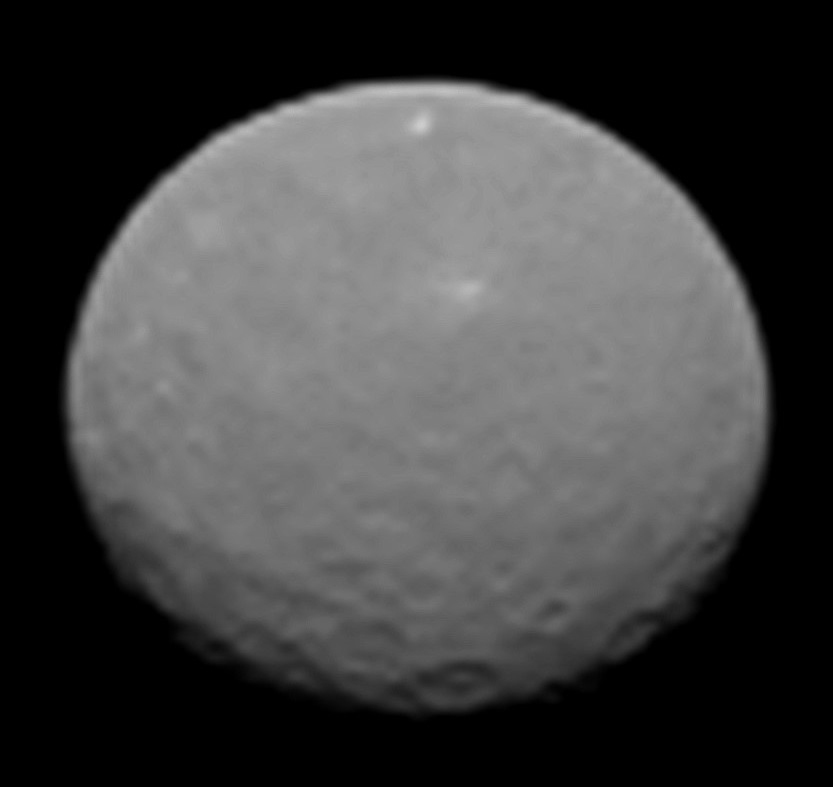
Given the surprising evidence of activity in some of the outer icy moons of the solar system, there is even speculation that liquid water could exist in pockets deep beneath Ceres’ surface, although much of the necessary radiogenic heat in its core has probably long since been lost to space, and there is no large body nearby to produce tidal heating. There has recently been evidence, however, from the Herschel Space Observatory of very small amounts of water vapour emanating from the surface of Ceres, so cryovolcanism is not ruled out, even if the water vapour may be the result of sublimation of ice caused by solar radiation.
Whatever surprises lie in store at Ceres, the Dawn team will be ready. Marc Rayman says “We are expecting changes when we get to Ceres and, fortunately, we built a very capable spacecraft and developed flexible plans to accommodate the unknowns. There’s great excitement in the unexpected—that’s part of the thrill of exploration.”
We look forward to reporting on the first results of Dawn’s primary mission at Ceres later in the year.
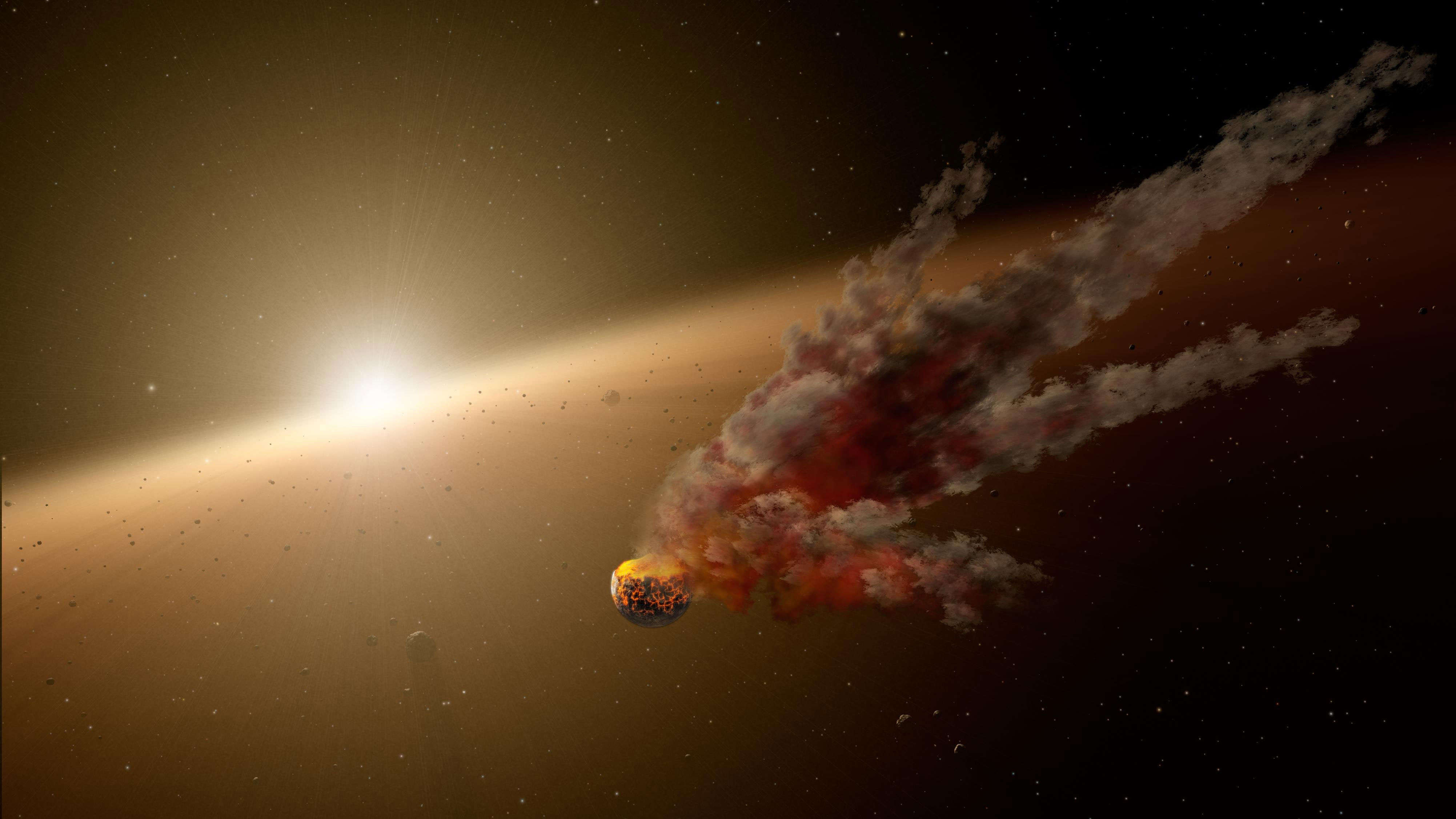
Additional references:
• For mission overview and news: http://dawn.jpl.nasa.gov/
• ‘UCLA Professor Leads NASA Dawn Mission’: http://www.bit.ly/dawnprof
• On ion propulsion: http://www.grc.nasa.gov/www/ion/
• On the early Solar System: ‘An Introduction to the Solar System’ – Ed. David A. Rothery, Neil McBride & Iain Gilmour (Cambridge University Press, 2011)

